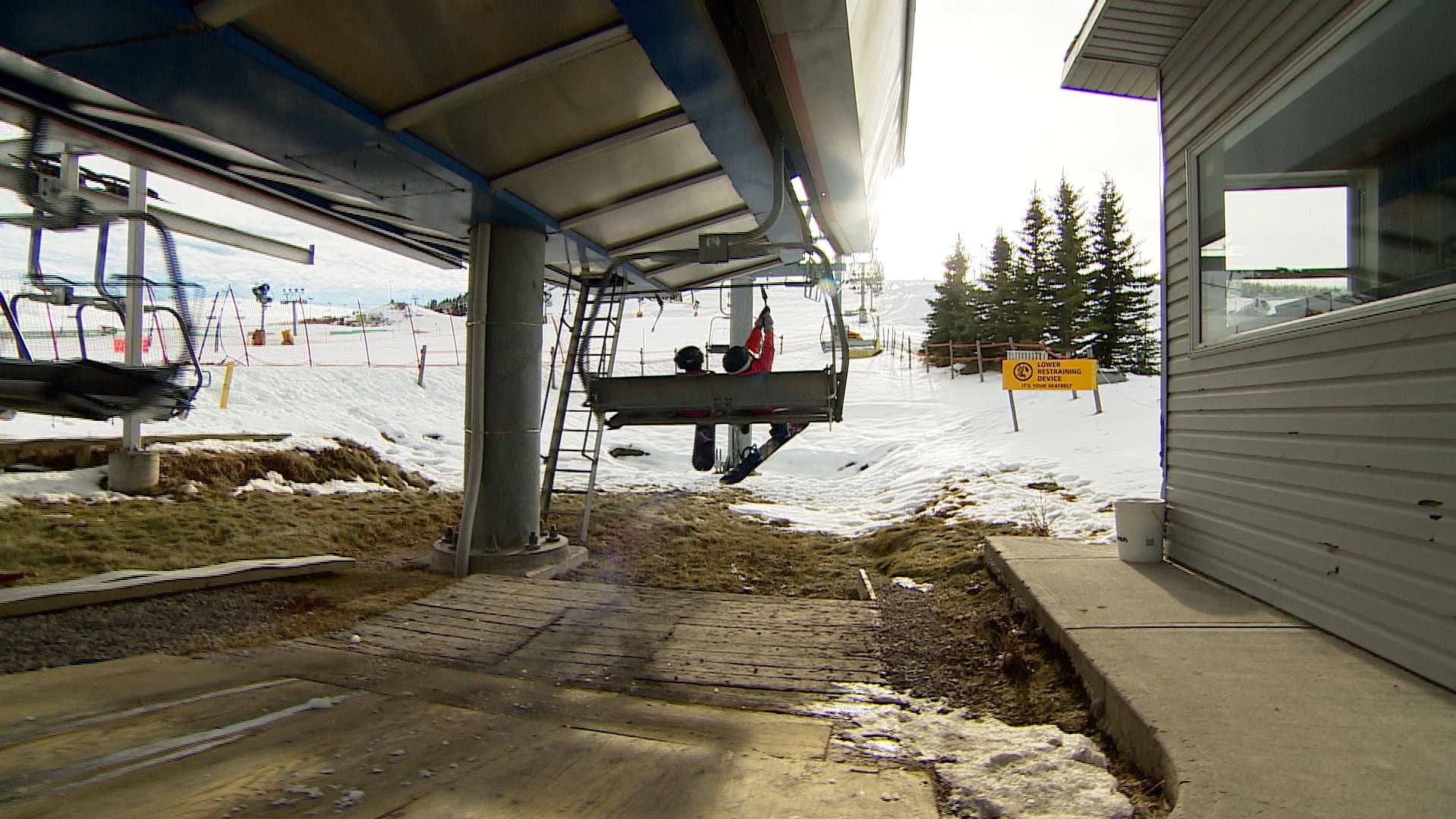Annual economic benefit of winter tourism in Western Canada pegged at $2.51 billion
The Prairies Climate Change Project is a joint initiative between CBC Edmonton and CBC Saskatchewan that focuses on weather and our changing climate. Meteorologist Christy Climenhaga brings her expert voice to the conversation to help explain weather phenomena and climate change and how they impact everyday life.
While some effects of climate change are pretty obvious — the heat dome of 2021, crippling droughts, major flood events and historic fire seasons — changes on Canada's ski hills through the decades have been a little more subtle.
Climate change contributed to milder winters, and we are seeing them even this January east of the Atlantic.
Record-breaking heat has been dominating much of Europe in this first week of 2023, with temperatures ranging from 10 to 20 degrees above seasonal in countries like Poland, Germany and France.
These unprecedented January temperatures are causing snow shortages, with many low-lying resorts in the Alps seeing runs interrupted by rock and mud.
Facing a challenging business environment and uncertain future as winters warm, there will be winners and losers depending on where you are in Canada and North America.
"I don't think there's ever going to be … a light-switch phenomenon where one day we have skiing and the next day we don't," says Micah Hewer, a University of Toronto research scientist studying the effects of climate change on winter tourism.
"There's been marked changes in the way that we experience winter and the way that these resorts have had to operate in order to remain profitable."
So, just what does adaptation look like for resorts? And what will it mean for an industry that, in Western Canada alone, is estimated to contribute economic benefits in the range of $2.51 billion annually and offers employment through about 28,000 jobs.
The case for adaptation
Beyond getting powder on the hills, resorts have adapted their business models to compensate for changes in season lengths.
Some now offer all-season activities to bring in more revenue in the greener months with things like golf courses, conference centres, mountain biking and water parks.

How will climate change impact your local ski hill?
As our climate continues to warm and precipitation patterns change, we can expect to see shorter ski seasons and higher operational costs — but the magnitude of change depends on geography.
Another option is amalgamations so that multiple properties across multiple ski areas create a cushion during challenging seasons, says Daniel Scott, a professor in geography and environmental management at the University of Waterloo.
"If you're a smaller mom-and-pop type of ski area, two bad seasons can diminish your cash reserves and you may not be able to operate in that third season," he says.
Scott, who studies the viability of the ski industry with climate change, says smaller towns known for skiing are also looking to add new tourism options into their future economic development strategies.
And on the business side of things, Scott says that if some resorts shutter due to changes in the climate, the demand will remain, and others could see more business.
"The places that are still in business will actually have to adapt to be able to handle bigger demand because there will be less places to go to as sort of supply shrinks."
And while skiers and snowboarders will find somewhere to go, the communities that rely on that traffic draw will be left in the cold.
"They are really important as an economic driver in some of those small towns."
Skiing on the Rockies, not so rocky
While some regions will feel the impacts of climate change more so than others, higher operating costs and slightly shorter seasons are likely across the board, Scott says.
In the future, successful ski seasons will really depend on where you are.
"We've done modelling throughout Canada, the U.S., much of Europe and then we've also looked at all of the different winter Olympic hosts … Canada does generally better than most places as a country," Scott says.
That being said, areas that have already felt a pinch, such as hills in Ontario, will continue to feel pressure with prolonged cold snaps, but record warm winters as well, Scott says.
According to Scott's research, even with advanced snow-making, Ontario, Quebec and the northeast U.S. will see shorter seasons by as much as 13 per cent under a low-emission scenario and as much as 22 per cent under a high-emission scenario by 2050.
Scott's research suggests that under a high-emission scenario, only 29 ski areas in Quebec and high-elevation areas of the U.S. northeast will be able to maintain a 100-day season and open regularly for the Christmas-New Year holiday, traditionally one of the biggest revenue periods, by the end of the century.
U.S. Thanksgiving could also be largely lost, Scott said.
Western Canada may be spared, however.
"Because you've got cold and because you've got elevation … we will still see a pretty reasonable average season length that wouldn't really test the viability of those businesses," Scott says.
"Alberta is a relative winner in the North American market, but some areas can be impacted by chinook winds, unlike B.C. Interior locations."
In the Rockies, the high elevation has sheltered ski resorts like Sunshine Village Ski Resort in Banff.
Kendra Scurfield, director of brand and communication at the resort, points to being high on the continental divide and 7,200 feet above sea level, as being part of a natural cushion against climate change.
"We are very fortunate because we are so high that the effects [of climate change] … we have not seen."

While alpine regions of Canada have been spared, resorts in the U.S. have felt the pinch.
"You have these pressures coming from different directions as a result of climate," says Auden Schendler, senior vice president of sustainability at Aspen Skiing Company in Colorado.
Schendler says the area has seen warmer, drier falls and a quicker melt in the spring.
"March is warming faster than any other month, which is worrisome because that's your profit in the ski industry. That's spring break and it's historically great skiing."
And even climate change impacts from the summertime will have an effect on the ski season in Colorado. Wildfires are taking a toll on the hills, Schendler says.
Schendler says businesses have found ways to make it through despite the pressure.
"The actual natural season is shortening for sure, but the industry is coping with that," he says.
"The business is able to make snow or move snow around to stay open."
Schendler says Aspen has taken steps to improve the sustainability of the ski business, through retrofitting light bulbs, installing solar panels and reducing its carbon footprint.
But he adds that adaptation needs to go beyond that, to the root of the problem — combating climate change on a global scale.
"We're really, really concerned and it will end our industry in the foreseeable future."
The case for and against snow-making
Snow-making is the double-edged sword of the ski industry: it is needed to prolong the season because there is less snow but, in terms of sustainability, some refer to it as a maladaptation.
"The two big concerns are water use and then the energy and greenhouse gas emissions that would go with it," Scott says.
Hewer adds that climate change is causing ski hills to essentially emit more greenhouse gases to try and create a skiable terrain.
"Indirectly they are … emitting more emissions into the atmosphere, which is then making the temperatures warmer."
Hewer says it may be a simplified look at a global phenomenon, but snow-making is a clear negative feedback loop within the industry.
"The more they try to adapt to climate change, the more they have to adapt to climate change."
But not all snow-making is the same.

Many areas in the mountains can get by with snow farming, or collecting snow and moving it where it needs to go.
Scurfield says that Sunshine Village in Banff uses this technique, setting up steel poles and fences in the summer.
"Those fences are used to catch every flake of snow as it falls," she says.
But when snow-making is needed, Scott says there are unsustainable practices out there.
Scott points to some California ski areas that use groundwater, for example, or areas in Colorado that are powered by coal-fired electricity with a very large carbon footprint.
"That's not a way to do snow-making," he says.
And in Canada, Scott says the water needed for snow-making is generally borrowed as opposed to used.
"The estimates we've seen, what you put up on the ski hill melts back down into the same watershed, about 80 to 90 per cent of it, the following spring," he says.
"Snow-making actually can be done quite sustainably."
Our planet is changing. So is our journalism. This story is part of a CBC News initiative entitled "Our Changing Planet" to show and explain the effects of climate change. Keep up with the latest news on our Climate and Environment page.
*****
Credit belongs to : www.cbc.ca
 MaharlikaNews | Canada Leading Online Filipino Newspaper Portal The No. 1 most engaged information website for Filipino – Canadian in Canada. MaharlikaNews.com received almost a quarter a million visitors in 2020.
MaharlikaNews | Canada Leading Online Filipino Newspaper Portal The No. 1 most engaged information website for Filipino – Canadian in Canada. MaharlikaNews.com received almost a quarter a million visitors in 2020.







